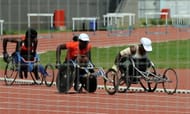The London Olympics 2012 had a huge impact in the field of sports and it was a great experience to work with the athletes. However, if there is one section of sport which I felt was completely overlooked, it is the wheel-chair sports. Especially with regard to the aspects of fitness and injury prevention/management. All the events which come under this category have the obvious physical requirement of propelling a wheelchair whilst using the arms. It’s a welcome move that nowadays India has started considering the services of physiotherapists, fitness trainers and mind trainers while participating in various championships as we experts understand the precise requirements of athletes. So the obvious question that arises from a sports physiotherapist’s perspective is regarding the common injuries suffered by wheelchair athletes.
The first thing that you notice when you watch elite wheel-chair athletes in action, is the incredible upper body strength that they possess. When the arms are all that you have to propel the wheelchair as fast as possible, it’s not surprising to find them being over-used (stressed) and prone to injury despite the upper limbs being well developed.
The most common injuries sustained by wheelchair athletes are soft tissue and nerve injuries in the upper extremity. These injuries include abrasions of the skin (due to falls and direct contact), sprains (ligaments of the shoulder and elbow), strains (upper extremity muscles), and contusions (from direct contact). All of the upper limb joints are susceptible including the shoulder, rotator cuff, arm, elbow, forearm, and wrist.
Muscular imbalances are a common cause of injuries in wheelchair athletes. Shoulder muscle imbalance, with weakness of the humeral head depressors (shoulder rotators and adductors), is a possible cause of ‘rotator cuff impingement syndrome’ in wheelchair-athletes. The humeral head depressors are comprised of the infraspinatus, subscapularis, teres minor and the long head of the biceps. Research has found that rotator cuff impingement is the most disabling injury experienced commonly by such athletes.
The reasons for the shoulder muscle imbalances are postural stress, repetitive movement, repetitive microtrauma, lack of core stability and altered neuro muscular efficiency. This can lead to the weakening of the humeral head depressors. The humeral head depressors reduce the impingement risk by depressing the humeral head as the arm is elevated. The action of the big powerful deltoid muscle is to lift the humerus, but in doing so it also elevates the humeral head into the acromian. This may then ‘squash’ the supraspinatus tendon, or the subacromial bursa or the bicep tendon. Strengthening the humeral head depressors would aid in the prevention and rehabilitation of rotator cuff impingement syndrome in wheelchair-athletes.
Bio-mechanics can play a role in the cause of injuries in wheelchair-athletes. Elbow and wrist injuries are predictable in wheelchair athletes based on the bio- mechanics of the sport. The throwing motion, wheelchair racing, shooting, racquet sports, and field events can repetitively stress the hand, wrist, and elbow. This type of repetitive stress can lead to overuse injuries such as muscle-tendon imbalances, strains, and abrasions. Correction of these muscle-tendon imbalances is accomplished by maintaining strength and flexibility of the shoulder, triceps, forearms flexors and extensors.
Elite wheelchair athletes will generally have well designed and efficient machines to get them around the track or court. However, the cost of these can be prohibitive for some. The design of the wheelchair can also impact the wheelchair athlete’s injury profile. Higher quality competitive wheelchairs that are light and have frictionless moveable components improve the mechanical efficiency of participants. Using a better designed wheelchair can help reduce the risks of injuries.
Therefore, it’s evident that trainers and physiotherapists play a pivotal role in enhancing the performance of these wheelchair-athletes. Such ‘special- sports’ definitely require more attention from all concerned in order to help these extraordinary athletes reach higher levels in the field of sports.

